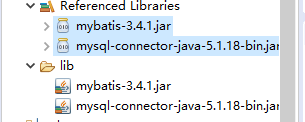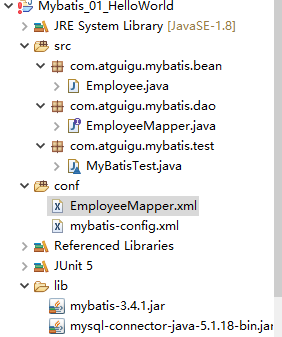版权声明:转载转载本博客文章必须声明出处,否则将追究其法律责任。 https://blog.csdn.net/vvcbvv/article/details/84292979
Mybatis初学创建一个MyBatis-Helloworld
1.首先建立一个bean类

2.建立一个测试类

3.导包

4.建立conf目录
(1)在conf目录下创建全局配置文件(mybatis-config.xml)
<?xml version="1.0" encoding="UTF-8" ?>
<!DOCTYPE configuration
PUBLIC "-//mybatis.org//DTD Config 3.0//EN"
"http://mybatis.org/dtd/mybatis-3-config.dtd">
<configuration>
<environments default="development">
<environment id="development">
<transactionManager type="JDBC"/>
<dataSource type="POOLED">
<property name="driver" value="com.mysql.jdbc.Driver"/>
<property name="url" value="jdbc:mysql://locallhost:3306/test"/>
<property name="username" value="数据库帐号"/>
<property name="password" value="数据库密码"/>
</dataSource>
</environment>
</environments>
<mappers>
<mapper resource="EmployeeMapper.xml"/>
</mappers>
</configuration>
(2)在conf目录下创建sql映射文件(EmployeeMapper.xml)
<?xml version="1.0" encoding="UTF-8" ?>
<!DOCTYPE mapper
PUBLIC "-//mybatis.org//DTD Mapper 3.0//EN"
"http://mybatis.org/dtd/mybatis-3-mapper.dtd">
<mapper namespace="com.atguigu.mybatis.dao.EmployeeMapper">
<!--
namespace:名称空间(指定为接口的全类名)
id:唯一标识
resultType:返回值类型(写bean的全类名)
-->
<select id="getEmployee" resultType="com.atguigu.mybatis.bean.Employee">
select * from testtable where id = #{id}
</select>
</mapper>
5.注意一定要将conf目录BuildPath一下
6.在测试类中写代码
1.根据xml配置文件(全局配置文件)创建一个SqlSessionFactory对象(目的为了创建SqlSession对象)
2.获取sqlsession实例,能直接执行已经映射的sql语句
一. 第一种方法(老式)
void test() throws IOException {
//1
SqlSessionFactory sqlSessionFactory = getSqlSessionFactory();
//2(selectOne方法中的第一个参数为sql的唯一标识符(防止冲突:用namespace+id)、第二个为执行sql语句的参数)
SqlSession openSession = sqlSessionFactory.openSession();
try {
Employee employee = openSession.selectOne("com.atguigu.mybatis.EmployeeMapper.selectEmplo", 66);
System.out.println("result:"+employee);
}finally {
openSession.close();
}
}
在第一种方法中selectOne方法中的第一个参数为sql的唯一标识符(防止冲突:用namespace+id【与sql映射文件EmployeeMapper.xml绑定】)、第二个为执行sql语句的参数(select * from testtable where id = #{id} 就是这条语句中#{id}的值)
二. 第二种方法(通过接口的方式,推荐使用第二种方法)
public void test01() throws IOException {
//1.获取sqlsessionFactory
SqlSessionFactory sqlSessionFactory = this.getSqlSessionFactory();
//2.获取sqlsession
SqlSession openSession = sqlSessionFactory.openSession();
//3.获取接口的实现类对象
try {
EmployeeMapper mapper = openSession.getMapper(EmployeeMapper.class);
Employee employee = mapper.getEmployee(66);
System.out.println("通过接口的方式输出:"+employee);
}finally {
openSession.close();
}
}
因为每次都要new一个sqlSessionFactory所以我把它封装成一个方法
private SqlSessionFactory getSqlSessionFactory() throws IOException {
String resource = "mybatis-config.xml";
InputStream inputStream = Resources.getResourceAsStream(resource);
SqlSessionFactory sqlSessionFactory = new SqlSessionFactoryBuilder().build(inputStream);
return sqlSessionFactory;
}
在第二种方法中需要创建一个接口并且与sql映射文件EmployeeMapper.xml动态绑定具体体现在
namespace:名称空间(指定为接口的全类名)
id:唯一标识(接口的方法名)
package com.atguigu.mybatis.dao;
import com.atguigu.mybatis.bean.Employee;
public interface EmployeeMapper {
public Employee getEmployee(Integer id);
}
最终运行结果

目录结构
